Designing Mobile Sensory Network for Solar Panel Monitoring System
VerifiedAdded on 2023/06/04
|23
|6350
|445
Project
AI Summary
This project focuses on designing a solar panel monitoring system using a sensory network that can be accessed through portable computing devices. The core aim is to mitigate the challenges associated with maintaining large solar arrays by enabling efficient fault detection and parameter verification. The system incorporates sensory networks to monitor solar panel conditions, providing notifications about faults and their precise locations, thereby saving time and resources for maintenance teams. Furthermore, the mobile accessibility of the system allows for real-time monitoring and immediate response to potential issues, enhancing the overall security and efficiency of the solar energy network. The project outlines the key components of both solar electric systems and sensory networks, discusses potential flaws in solar panels, and proposes the development of a mobile application to facilitate seamless monitoring and control.
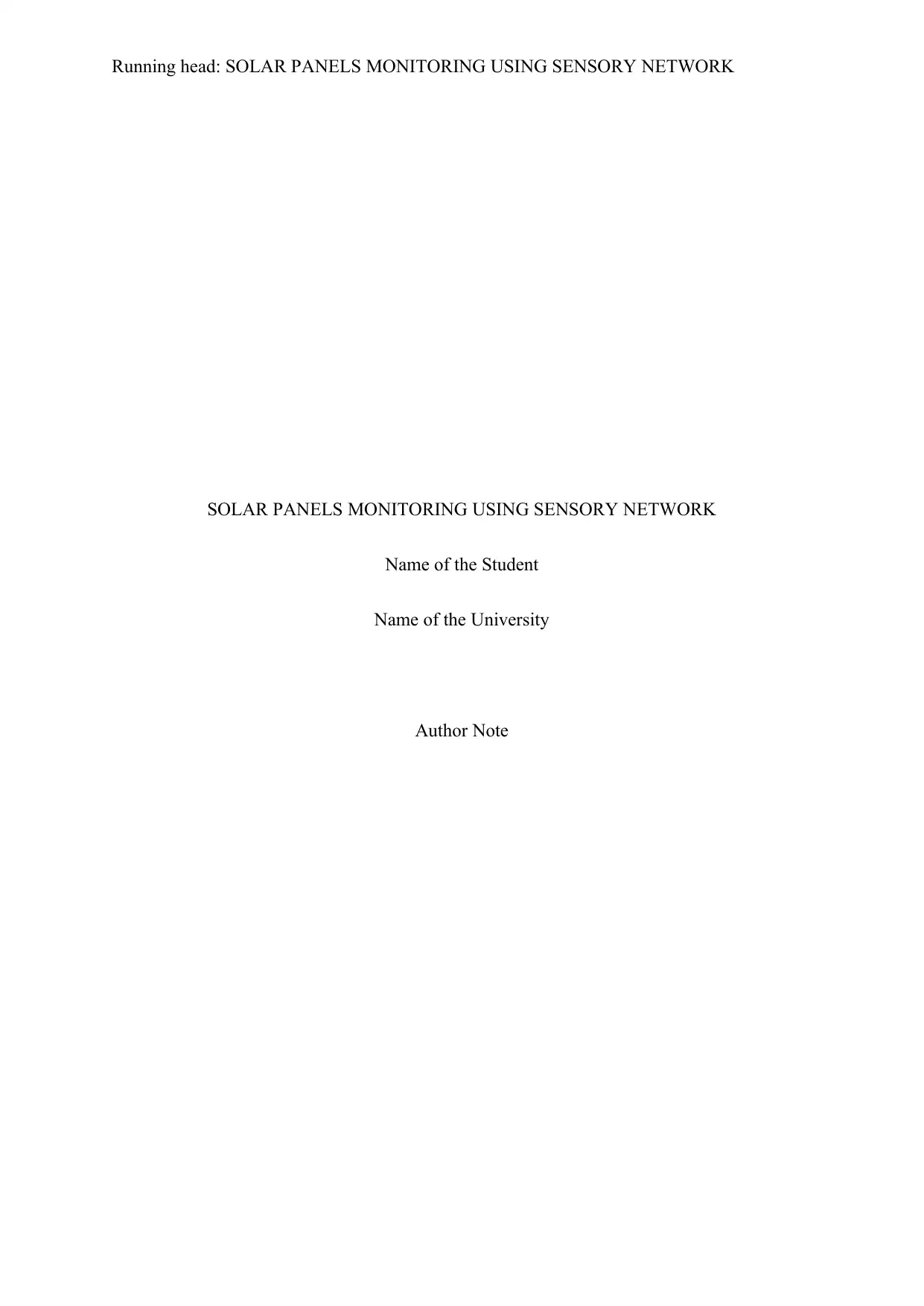
Running head: SOLAR PANELS MONITORING USING SENSORY NETWORK
SOLAR PANELS MONITORING USING SENSORY NETWORK
Name of the Student
Name of the University
Author Note
SOLAR PANELS MONITORING USING SENSORY NETWORK
Name of the Student
Name of the University
Author Note
Paraphrase This Document
Need a fresh take? Get an instant paraphrase of this document with our AI Paraphraser
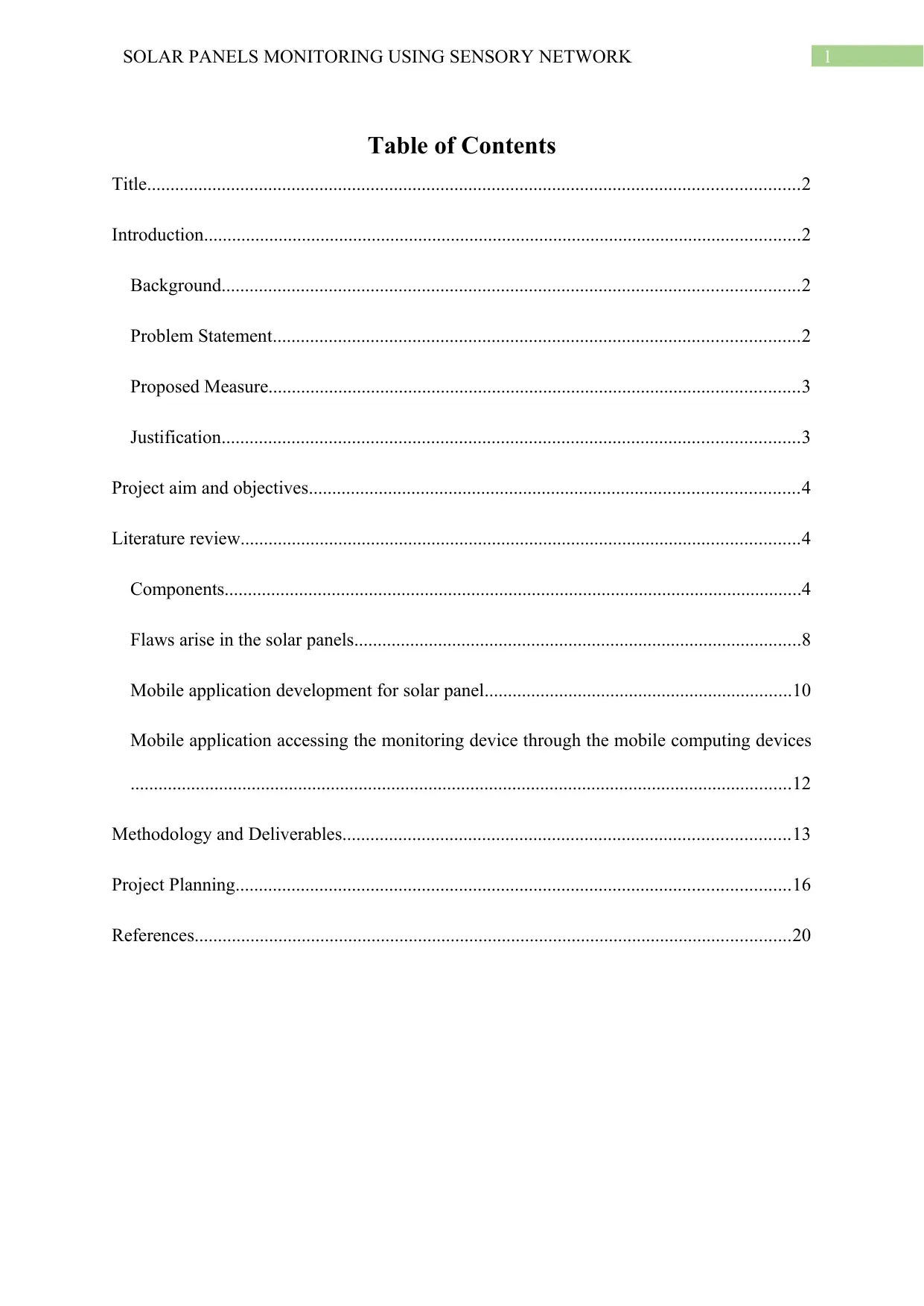
1SOLAR PANELS MONITORING USING SENSORY NETWORK
Table of Contents
Title............................................................................................................................................2
Introduction................................................................................................................................2
Background............................................................................................................................2
Problem Statement.................................................................................................................2
Proposed Measure..................................................................................................................3
Justification............................................................................................................................3
Project aim and objectives.........................................................................................................4
Literature review........................................................................................................................4
Components............................................................................................................................4
Flaws arise in the solar panels................................................................................................8
Mobile application development for solar panel..................................................................10
Mobile application accessing the monitoring device through the mobile computing devices
..............................................................................................................................................12
Methodology and Deliverables................................................................................................13
Project Planning.......................................................................................................................16
References................................................................................................................................20
Table of Contents
Title............................................................................................................................................2
Introduction................................................................................................................................2
Background............................................................................................................................2
Problem Statement.................................................................................................................2
Proposed Measure..................................................................................................................3
Justification............................................................................................................................3
Project aim and objectives.........................................................................................................4
Literature review........................................................................................................................4
Components............................................................................................................................4
Flaws arise in the solar panels................................................................................................8
Mobile application development for solar panel..................................................................10
Mobile application accessing the monitoring device through the mobile computing devices
..............................................................................................................................................12
Methodology and Deliverables................................................................................................13
Project Planning.......................................................................................................................16
References................................................................................................................................20
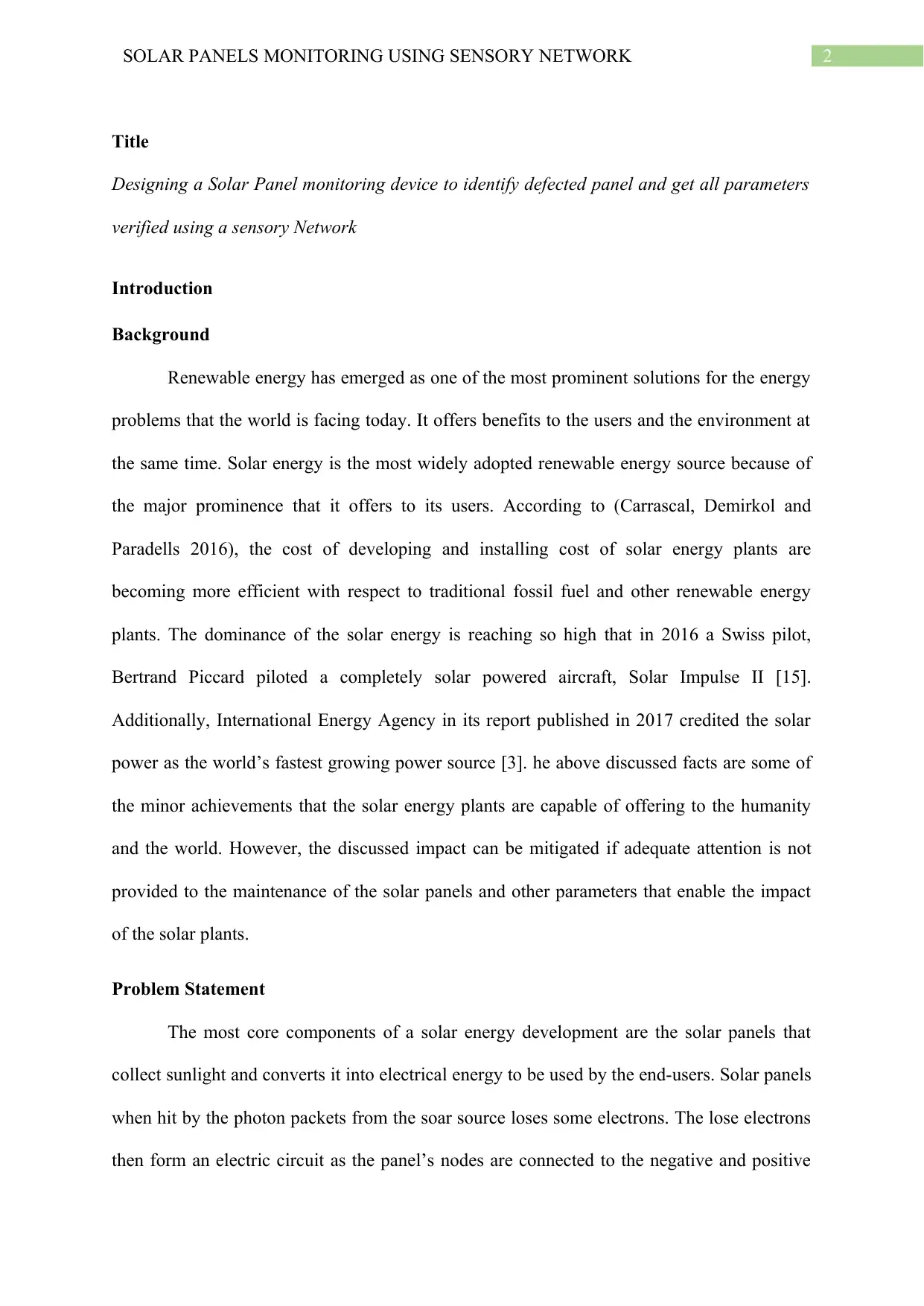
2SOLAR PANELS MONITORING USING SENSORY NETWORK
Title
Designing a Solar Panel monitoring device to identify defected panel and get all parameters
verified using a sensory Network
Introduction
Background
Renewable energy has emerged as one of the most prominent solutions for the energy
problems that the world is facing today. It offers benefits to the users and the environment at
the same time. Solar energy is the most widely adopted renewable energy source because of
the major prominence that it offers to its users. According to (Carrascal, Demirkol and
Paradells 2016), the cost of developing and installing cost of solar energy plants are
becoming more efficient with respect to traditional fossil fuel and other renewable energy
plants. The dominance of the solar energy is reaching so high that in 2016 a Swiss pilot,
Bertrand Piccard piloted a completely solar powered aircraft, Solar Impulse II [15].
Additionally, International Energy Agency in its report published in 2017 credited the solar
power as the world’s fastest growing power source [3]. he above discussed facts are some of
the minor achievements that the solar energy plants are capable of offering to the humanity
and the world. However, the discussed impact can be mitigated if adequate attention is not
provided to the maintenance of the solar panels and other parameters that enable the impact
of the solar plants.
Problem Statement
The most core components of a solar energy development are the solar panels that
collect sunlight and converts it into electrical energy to be used by the end-users. Solar panels
when hit by the photon packets from the soar source loses some electrons. The lose electrons
then form an electric circuit as the panel’s nodes are connected to the negative and positive
Title
Designing a Solar Panel monitoring device to identify defected panel and get all parameters
verified using a sensory Network
Introduction
Background
Renewable energy has emerged as one of the most prominent solutions for the energy
problems that the world is facing today. It offers benefits to the users and the environment at
the same time. Solar energy is the most widely adopted renewable energy source because of
the major prominence that it offers to its users. According to (Carrascal, Demirkol and
Paradells 2016), the cost of developing and installing cost of solar energy plants are
becoming more efficient with respect to traditional fossil fuel and other renewable energy
plants. The dominance of the solar energy is reaching so high that in 2016 a Swiss pilot,
Bertrand Piccard piloted a completely solar powered aircraft, Solar Impulse II [15].
Additionally, International Energy Agency in its report published in 2017 credited the solar
power as the world’s fastest growing power source [3]. he above discussed facts are some of
the minor achievements that the solar energy plants are capable of offering to the humanity
and the world. However, the discussed impact can be mitigated if adequate attention is not
provided to the maintenance of the solar panels and other parameters that enable the impact
of the solar plants.
Problem Statement
The most core components of a solar energy development are the solar panels that
collect sunlight and converts it into electrical energy to be used by the end-users. Solar panels
when hit by the photon packets from the soar source loses some electrons. The lose electrons
then form an electric circuit as the panel’s nodes are connected to the negative and positive
⊘ This is a preview!⊘
Do you want full access?
Subscribe today to unlock all pages.

Trusted by 1+ million students worldwide
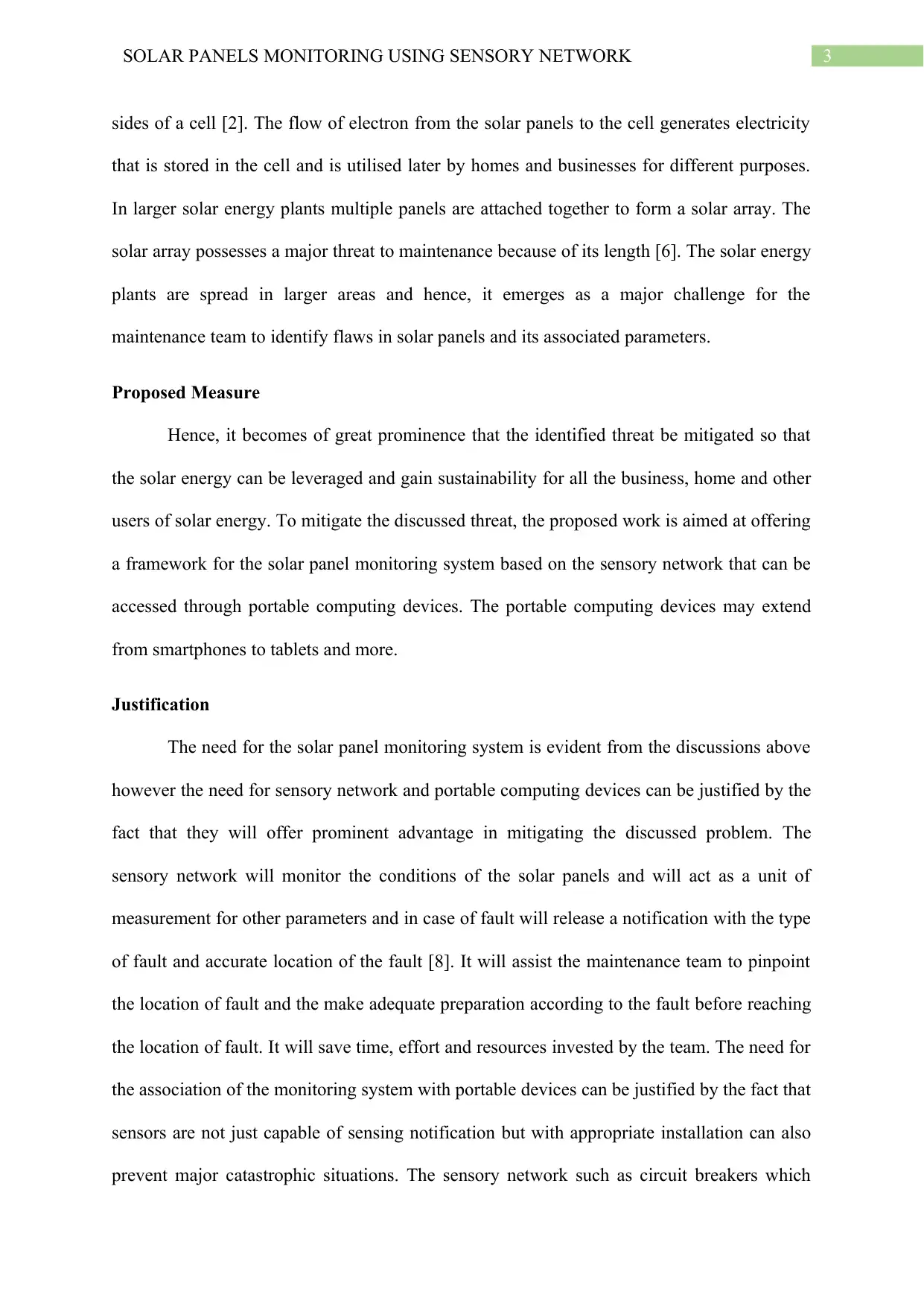
3SOLAR PANELS MONITORING USING SENSORY NETWORK
sides of a cell [2]. The flow of electron from the solar panels to the cell generates electricity
that is stored in the cell and is utilised later by homes and businesses for different purposes.
In larger solar energy plants multiple panels are attached together to form a solar array. The
solar array possesses a major threat to maintenance because of its length [6]. The solar energy
plants are spread in larger areas and hence, it emerges as a major challenge for the
maintenance team to identify flaws in solar panels and its associated parameters.
Proposed Measure
Hence, it becomes of great prominence that the identified threat be mitigated so that
the solar energy can be leveraged and gain sustainability for all the business, home and other
users of solar energy. To mitigate the discussed threat, the proposed work is aimed at offering
a framework for the solar panel monitoring system based on the sensory network that can be
accessed through portable computing devices. The portable computing devices may extend
from smartphones to tablets and more.
Justification
The need for the solar panel monitoring system is evident from the discussions above
however the need for sensory network and portable computing devices can be justified by the
fact that they will offer prominent advantage in mitigating the discussed problem. The
sensory network will monitor the conditions of the solar panels and will act as a unit of
measurement for other parameters and in case of fault will release a notification with the type
of fault and accurate location of the fault [8]. It will assist the maintenance team to pinpoint
the location of fault and the make adequate preparation according to the fault before reaching
the location of fault. It will save time, effort and resources invested by the team. The need for
the association of the monitoring system with portable devices can be justified by the fact that
sensors are not just capable of sensing notification but with appropriate installation can also
prevent major catastrophic situations. The sensory network such as circuit breakers which
sides of a cell [2]. The flow of electron from the solar panels to the cell generates electricity
that is stored in the cell and is utilised later by homes and businesses for different purposes.
In larger solar energy plants multiple panels are attached together to form a solar array. The
solar array possesses a major threat to maintenance because of its length [6]. The solar energy
plants are spread in larger areas and hence, it emerges as a major challenge for the
maintenance team to identify flaws in solar panels and its associated parameters.
Proposed Measure
Hence, it becomes of great prominence that the identified threat be mitigated so that
the solar energy can be leveraged and gain sustainability for all the business, home and other
users of solar energy. To mitigate the discussed threat, the proposed work is aimed at offering
a framework for the solar panel monitoring system based on the sensory network that can be
accessed through portable computing devices. The portable computing devices may extend
from smartphones to tablets and more.
Justification
The need for the solar panel monitoring system is evident from the discussions above
however the need for sensory network and portable computing devices can be justified by the
fact that they will offer prominent advantage in mitigating the discussed problem. The
sensory network will monitor the conditions of the solar panels and will act as a unit of
measurement for other parameters and in case of fault will release a notification with the type
of fault and accurate location of the fault [8]. It will assist the maintenance team to pinpoint
the location of fault and the make adequate preparation according to the fault before reaching
the location of fault. It will save time, effort and resources invested by the team. The need for
the association of the monitoring system with portable devices can be justified by the fact that
sensors are not just capable of sensing notification but with appropriate installation can also
prevent major catastrophic situations. The sensory network such as circuit breakers which
Paraphrase This Document
Need a fresh take? Get an instant paraphrase of this document with our AI Paraphraser
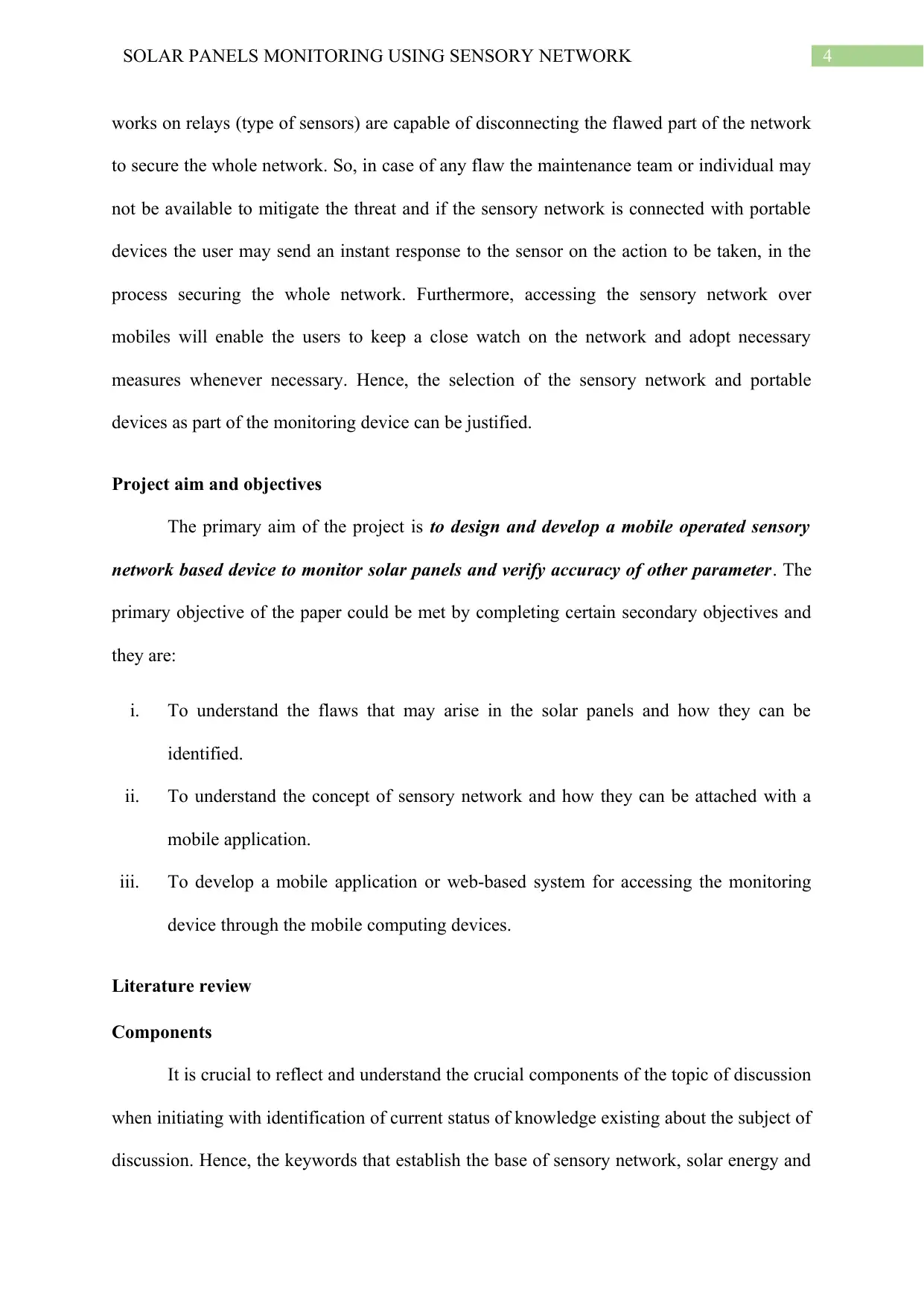
4SOLAR PANELS MONITORING USING SENSORY NETWORK
works on relays (type of sensors) are capable of disconnecting the flawed part of the network
to secure the whole network. So, in case of any flaw the maintenance team or individual may
not be available to mitigate the threat and if the sensory network is connected with portable
devices the user may send an instant response to the sensor on the action to be taken, in the
process securing the whole network. Furthermore, accessing the sensory network over
mobiles will enable the users to keep a close watch on the network and adopt necessary
measures whenever necessary. Hence, the selection of the sensory network and portable
devices as part of the monitoring device can be justified.
Project aim and objectives
The primary aim of the project is to design and develop a mobile operated sensory
network based device to monitor solar panels and verify accuracy of other parameter. The
primary objective of the paper could be met by completing certain secondary objectives and
they are:
i. To understand the flaws that may arise in the solar panels and how they can be
identified.
ii. To understand the concept of sensory network and how they can be attached with a
mobile application.
iii. To develop a mobile application or web-based system for accessing the monitoring
device through the mobile computing devices.
Literature review
Components
It is crucial to reflect and understand the crucial components of the topic of discussion
when initiating with identification of current status of knowledge existing about the subject of
discussion. Hence, the keywords that establish the base of sensory network, solar energy and
works on relays (type of sensors) are capable of disconnecting the flawed part of the network
to secure the whole network. So, in case of any flaw the maintenance team or individual may
not be available to mitigate the threat and if the sensory network is connected with portable
devices the user may send an instant response to the sensor on the action to be taken, in the
process securing the whole network. Furthermore, accessing the sensory network over
mobiles will enable the users to keep a close watch on the network and adopt necessary
measures whenever necessary. Hence, the selection of the sensory network and portable
devices as part of the monitoring device can be justified.
Project aim and objectives
The primary aim of the project is to design and develop a mobile operated sensory
network based device to monitor solar panels and verify accuracy of other parameter. The
primary objective of the paper could be met by completing certain secondary objectives and
they are:
i. To understand the flaws that may arise in the solar panels and how they can be
identified.
ii. To understand the concept of sensory network and how they can be attached with a
mobile application.
iii. To develop a mobile application or web-based system for accessing the monitoring
device through the mobile computing devices.
Literature review
Components
It is crucial to reflect and understand the crucial components of the topic of discussion
when initiating with identification of current status of knowledge existing about the subject of
discussion. Hence, the keywords that establish the base of sensory network, solar energy and
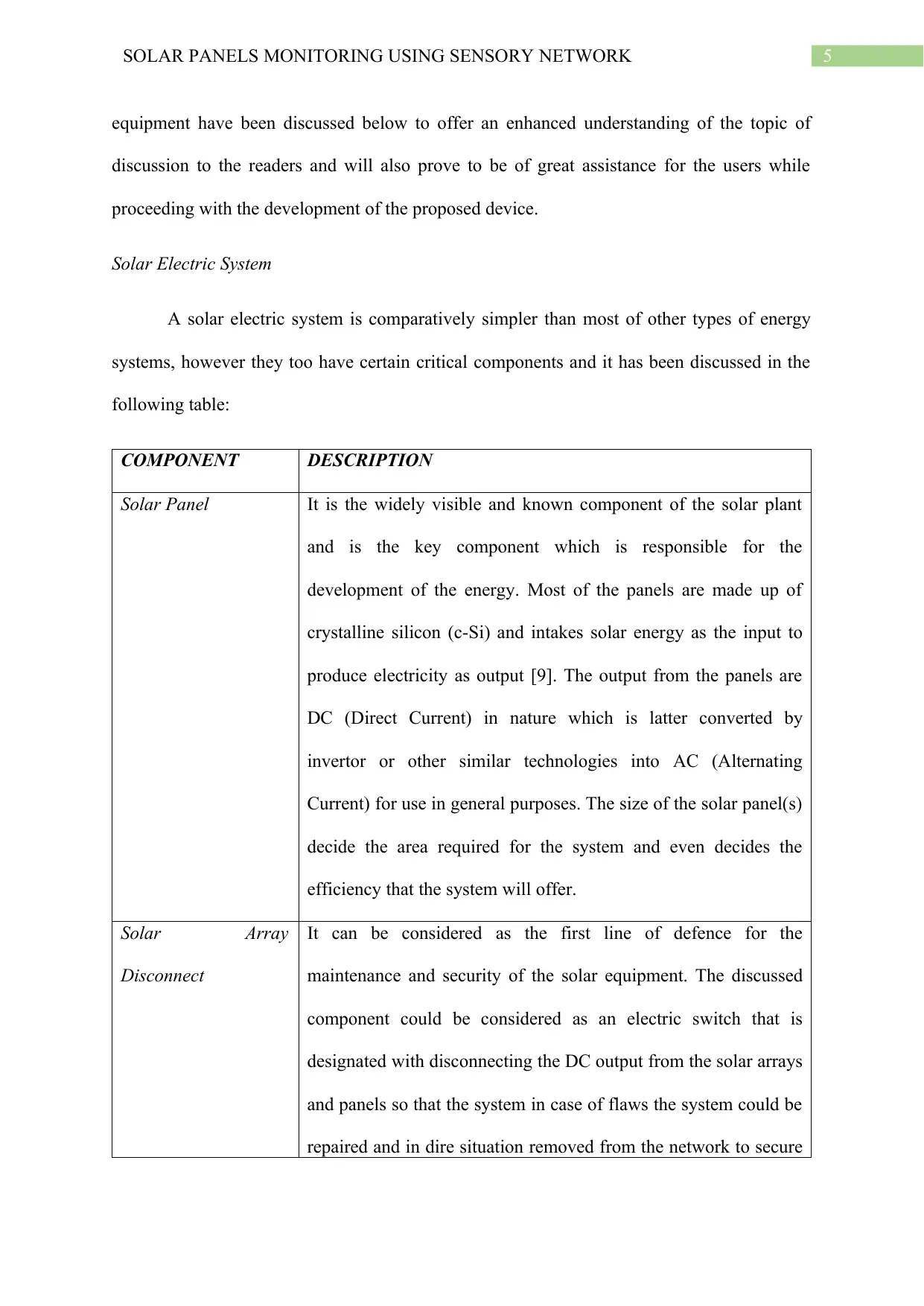
5SOLAR PANELS MONITORING USING SENSORY NETWORK
equipment have been discussed below to offer an enhanced understanding of the topic of
discussion to the readers and will also prove to be of great assistance for the users while
proceeding with the development of the proposed device.
Solar Electric System
A solar electric system is comparatively simpler than most of other types of energy
systems, however they too have certain critical components and it has been discussed in the
following table:
COMPONENT DESCRIPTION
Solar Panel It is the widely visible and known component of the solar plant
and is the key component which is responsible for the
development of the energy. Most of the panels are made up of
crystalline silicon (c-Si) and intakes solar energy as the input to
produce electricity as output [9]. The output from the panels are
DC (Direct Current) in nature which is latter converted by
invertor or other similar technologies into AC (Alternating
Current) for use in general purposes. The size of the solar panel(s)
decide the area required for the system and even decides the
efficiency that the system will offer.
Solar Array
Disconnect
It can be considered as the first line of defence for the
maintenance and security of the solar equipment. The discussed
component could be considered as an electric switch that is
designated with disconnecting the DC output from the solar arrays
and panels so that the system in case of flaws the system could be
repaired and in dire situation removed from the network to secure
equipment have been discussed below to offer an enhanced understanding of the topic of
discussion to the readers and will also prove to be of great assistance for the users while
proceeding with the development of the proposed device.
Solar Electric System
A solar electric system is comparatively simpler than most of other types of energy
systems, however they too have certain critical components and it has been discussed in the
following table:
COMPONENT DESCRIPTION
Solar Panel It is the widely visible and known component of the solar plant
and is the key component which is responsible for the
development of the energy. Most of the panels are made up of
crystalline silicon (c-Si) and intakes solar energy as the input to
produce electricity as output [9]. The output from the panels are
DC (Direct Current) in nature which is latter converted by
invertor or other similar technologies into AC (Alternating
Current) for use in general purposes. The size of the solar panel(s)
decide the area required for the system and even decides the
efficiency that the system will offer.
Solar Array
Disconnect
It can be considered as the first line of defence for the
maintenance and security of the solar equipment. The discussed
component could be considered as an electric switch that is
designated with disconnecting the DC output from the solar arrays
and panels so that the system in case of flaws the system could be
repaired and in dire situation removed from the network to secure
⊘ This is a preview!⊘
Do you want full access?
Subscribe today to unlock all pages.

Trusted by 1+ million students worldwide
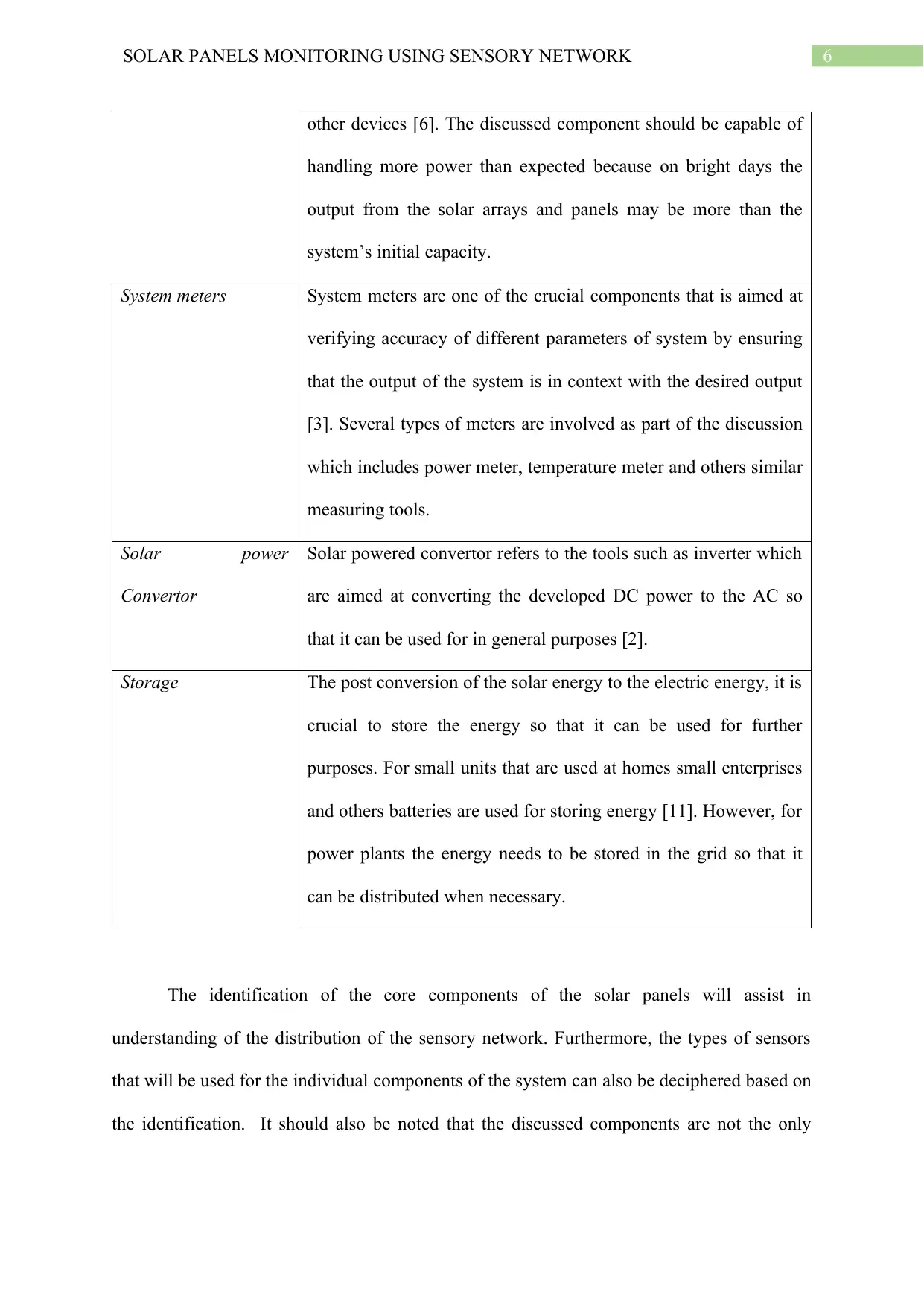
6SOLAR PANELS MONITORING USING SENSORY NETWORK
other devices [6]. The discussed component should be capable of
handling more power than expected because on bright days the
output from the solar arrays and panels may be more than the
system’s initial capacity.
System meters System meters are one of the crucial components that is aimed at
verifying accuracy of different parameters of system by ensuring
that the output of the system is in context with the desired output
[3]. Several types of meters are involved as part of the discussion
which includes power meter, temperature meter and others similar
measuring tools.
Solar power
Convertor
Solar powered convertor refers to the tools such as inverter which
are aimed at converting the developed DC power to the AC so
that it can be used for in general purposes [2].
Storage The post conversion of the solar energy to the electric energy, it is
crucial to store the energy so that it can be used for further
purposes. For small units that are used at homes small enterprises
and others batteries are used for storing energy [11]. However, for
power plants the energy needs to be stored in the grid so that it
can be distributed when necessary.
The identification of the core components of the solar panels will assist in
understanding of the distribution of the sensory network. Furthermore, the types of sensors
that will be used for the individual components of the system can also be deciphered based on
the identification. It should also be noted that the discussed components are not the only
other devices [6]. The discussed component should be capable of
handling more power than expected because on bright days the
output from the solar arrays and panels may be more than the
system’s initial capacity.
System meters System meters are one of the crucial components that is aimed at
verifying accuracy of different parameters of system by ensuring
that the output of the system is in context with the desired output
[3]. Several types of meters are involved as part of the discussion
which includes power meter, temperature meter and others similar
measuring tools.
Solar power
Convertor
Solar powered convertor refers to the tools such as inverter which
are aimed at converting the developed DC power to the AC so
that it can be used for in general purposes [2].
Storage The post conversion of the solar energy to the electric energy, it is
crucial to store the energy so that it can be used for further
purposes. For small units that are used at homes small enterprises
and others batteries are used for storing energy [11]. However, for
power plants the energy needs to be stored in the grid so that it
can be distributed when necessary.
The identification of the core components of the solar panels will assist in
understanding of the distribution of the sensory network. Furthermore, the types of sensors
that will be used for the individual components of the system can also be deciphered based on
the identification. It should also be noted that the discussed components are not the only
Paraphrase This Document
Need a fresh take? Get an instant paraphrase of this document with our AI Paraphraser

7SOLAR PANELS MONITORING USING SENSORY NETWORK
components that complete a solar power system but the discussed ones are the core
components and needs to be assessed.
The table attached below discusses the core components of the sensory network and
identification of the core components will enable the author of the discussed paper in
developing a base for the establishing the sensory network that will assist in monitoring of
the solar panels and verification of other parameters.
COMPONENTS DESCRIPTION
Sensors Sensors are the electronic device that measures or detects physical
records and properties and accordingly indicates or responds to it
[17]. The discussed devices are the most basic component of the
sensory network and will be attached with the components of the
solar power system for the collection and distribution of data for
processing at the base station.
Nodes Nodes are referred to as the point where intersection. In case of a
sensory network the nodes are designated with the responsibility
to gather sensory information, conduct minor processing and
communicating with other nodes & the gateway for the transfer of
data [19]. The node can vary according to the need of the network
and most common types are leaf node, relay node and others.
Gateway Gateway refers to the interface between the nodes and the
controlling application. The information collected from the nodes
will be manipulated/ aggregated from the gateway and moved to
the application for further processing [18]. It also holds
responsibility for intimating the nodes about the necessary action
components that complete a solar power system but the discussed ones are the core
components and needs to be assessed.
The table attached below discusses the core components of the sensory network and
identification of the core components will enable the author of the discussed paper in
developing a base for the establishing the sensory network that will assist in monitoring of
the solar panels and verification of other parameters.
COMPONENTS DESCRIPTION
Sensors Sensors are the electronic device that measures or detects physical
records and properties and accordingly indicates or responds to it
[17]. The discussed devices are the most basic component of the
sensory network and will be attached with the components of the
solar power system for the collection and distribution of data for
processing at the base station.
Nodes Nodes are referred to as the point where intersection. In case of a
sensory network the nodes are designated with the responsibility
to gather sensory information, conduct minor processing and
communicating with other nodes & the gateway for the transfer of
data [19]. The node can vary according to the need of the network
and most common types are leaf node, relay node and others.
Gateway Gateway refers to the interface between the nodes and the
controlling application. The information collected from the nodes
will be manipulated/ aggregated from the gateway and moved to
the application for further processing [18]. It also holds
responsibility for intimating the nodes about the necessary action
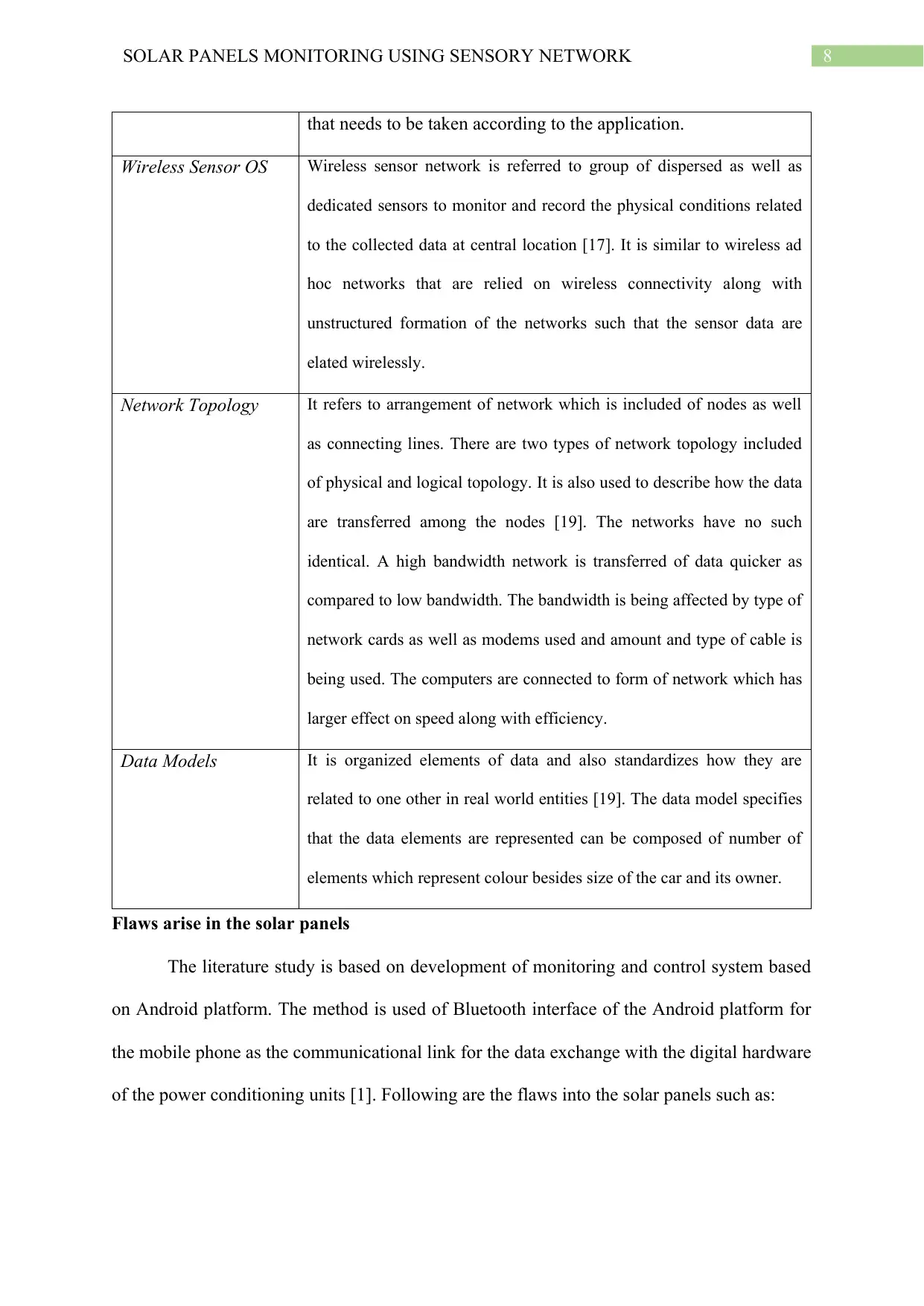
8SOLAR PANELS MONITORING USING SENSORY NETWORK
that needs to be taken according to the application.
Wireless Sensor OS Wireless sensor network is referred to group of dispersed as well as
dedicated sensors to monitor and record the physical conditions related
to the collected data at central location [17]. It is similar to wireless ad
hoc networks that are relied on wireless connectivity along with
unstructured formation of the networks such that the sensor data are
elated wirelessly.
Network Topology It refers to arrangement of network which is included of nodes as well
as connecting lines. There are two types of network topology included
of physical and logical topology. It is also used to describe how the data
are transferred among the nodes [19]. The networks have no such
identical. A high bandwidth network is transferred of data quicker as
compared to low bandwidth. The bandwidth is being affected by type of
network cards as well as modems used and amount and type of cable is
being used. The computers are connected to form of network which has
larger effect on speed along with efficiency.
Data Models It is organized elements of data and also standardizes how they are
related to one other in real world entities [19]. The data model specifies
that the data elements are represented can be composed of number of
elements which represent colour besides size of the car and its owner.
Flaws arise in the solar panels
The literature study is based on development of monitoring and control system based
on Android platform. The method is used of Bluetooth interface of the Android platform for
the mobile phone as the communicational link for the data exchange with the digital hardware
of the power conditioning units [1]. Following are the flaws into the solar panels such as:
that needs to be taken according to the application.
Wireless Sensor OS Wireless sensor network is referred to group of dispersed as well as
dedicated sensors to monitor and record the physical conditions related
to the collected data at central location [17]. It is similar to wireless ad
hoc networks that are relied on wireless connectivity along with
unstructured formation of the networks such that the sensor data are
elated wirelessly.
Network Topology It refers to arrangement of network which is included of nodes as well
as connecting lines. There are two types of network topology included
of physical and logical topology. It is also used to describe how the data
are transferred among the nodes [19]. The networks have no such
identical. A high bandwidth network is transferred of data quicker as
compared to low bandwidth. The bandwidth is being affected by type of
network cards as well as modems used and amount and type of cable is
being used. The computers are connected to form of network which has
larger effect on speed along with efficiency.
Data Models It is organized elements of data and also standardizes how they are
related to one other in real world entities [19]. The data model specifies
that the data elements are represented can be composed of number of
elements which represent colour besides size of the car and its owner.
Flaws arise in the solar panels
The literature study is based on development of monitoring and control system based
on Android platform. The method is used of Bluetooth interface of the Android platform for
the mobile phone as the communicational link for the data exchange with the digital hardware
of the power conditioning units [1]. Following are the flaws into the solar panels such as:
⊘ This is a preview!⊘
Do you want full access?
Subscribe today to unlock all pages.

Trusted by 1+ million students worldwide
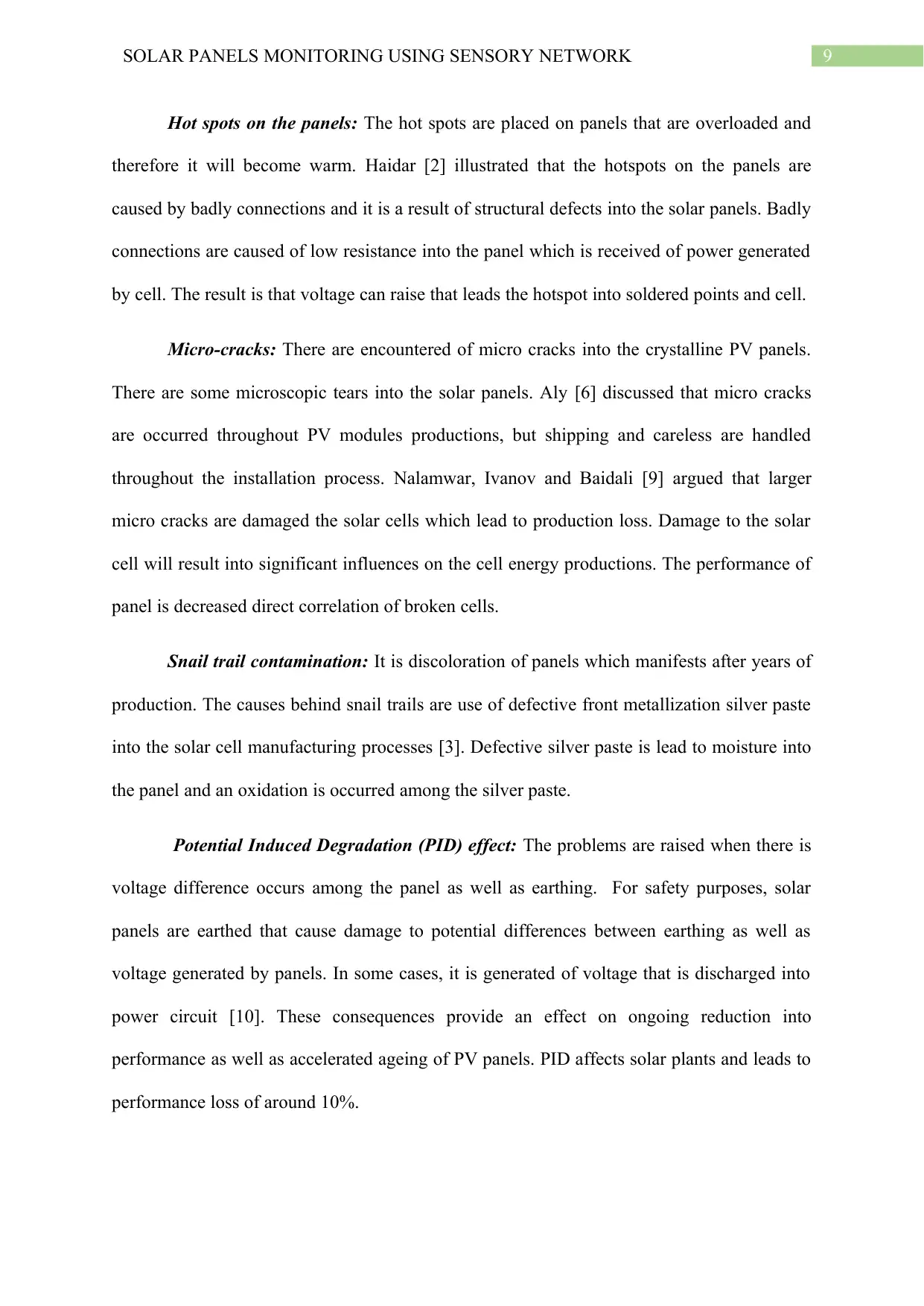
9SOLAR PANELS MONITORING USING SENSORY NETWORK
Hot spots on the panels: The hot spots are placed on panels that are overloaded and
therefore it will become warm. Haidar [2] illustrated that the hotspots on the panels are
caused by badly connections and it is a result of structural defects into the solar panels. Badly
connections are caused of low resistance into the panel which is received of power generated
by cell. The result is that voltage can raise that leads the hotspot into soldered points and cell.
Micro-cracks: There are encountered of micro cracks into the crystalline PV panels.
There are some microscopic tears into the solar panels. Aly [6] discussed that micro cracks
are occurred throughout PV modules productions, but shipping and careless are handled
throughout the installation process. Nalamwar, Ivanov and Baidali [9] argued that larger
micro cracks are damaged the solar cells which lead to production loss. Damage to the solar
cell will result into significant influences on the cell energy productions. The performance of
panel is decreased direct correlation of broken cells.
Snail trail contamination: It is discoloration of panels which manifests after years of
production. The causes behind snail trails are use of defective front metallization silver paste
into the solar cell manufacturing processes [3]. Defective silver paste is lead to moisture into
the panel and an oxidation is occurred among the silver paste.
Potential Induced Degradation (PID) effect: The problems are raised when there is
voltage difference occurs among the panel as well as earthing. For safety purposes, solar
panels are earthed that cause damage to potential differences between earthing as well as
voltage generated by panels. In some cases, it is generated of voltage that is discharged into
power circuit [10]. These consequences provide an effect on ongoing reduction into
performance as well as accelerated ageing of PV panels. PID affects solar plants and leads to
performance loss of around 10%.
Hot spots on the panels: The hot spots are placed on panels that are overloaded and
therefore it will become warm. Haidar [2] illustrated that the hotspots on the panels are
caused by badly connections and it is a result of structural defects into the solar panels. Badly
connections are caused of low resistance into the panel which is received of power generated
by cell. The result is that voltage can raise that leads the hotspot into soldered points and cell.
Micro-cracks: There are encountered of micro cracks into the crystalline PV panels.
There are some microscopic tears into the solar panels. Aly [6] discussed that micro cracks
are occurred throughout PV modules productions, but shipping and careless are handled
throughout the installation process. Nalamwar, Ivanov and Baidali [9] argued that larger
micro cracks are damaged the solar cells which lead to production loss. Damage to the solar
cell will result into significant influences on the cell energy productions. The performance of
panel is decreased direct correlation of broken cells.
Snail trail contamination: It is discoloration of panels which manifests after years of
production. The causes behind snail trails are use of defective front metallization silver paste
into the solar cell manufacturing processes [3]. Defective silver paste is lead to moisture into
the panel and an oxidation is occurred among the silver paste.
Potential Induced Degradation (PID) effect: The problems are raised when there is
voltage difference occurs among the panel as well as earthing. For safety purposes, solar
panels are earthed that cause damage to potential differences between earthing as well as
voltage generated by panels. In some cases, it is generated of voltage that is discharged into
power circuit [10]. These consequences provide an effect on ongoing reduction into
performance as well as accelerated ageing of PV panels. PID affects solar plants and leads to
performance loss of around 10%.
Paraphrase This Document
Need a fresh take? Get an instant paraphrase of this document with our AI Paraphraser
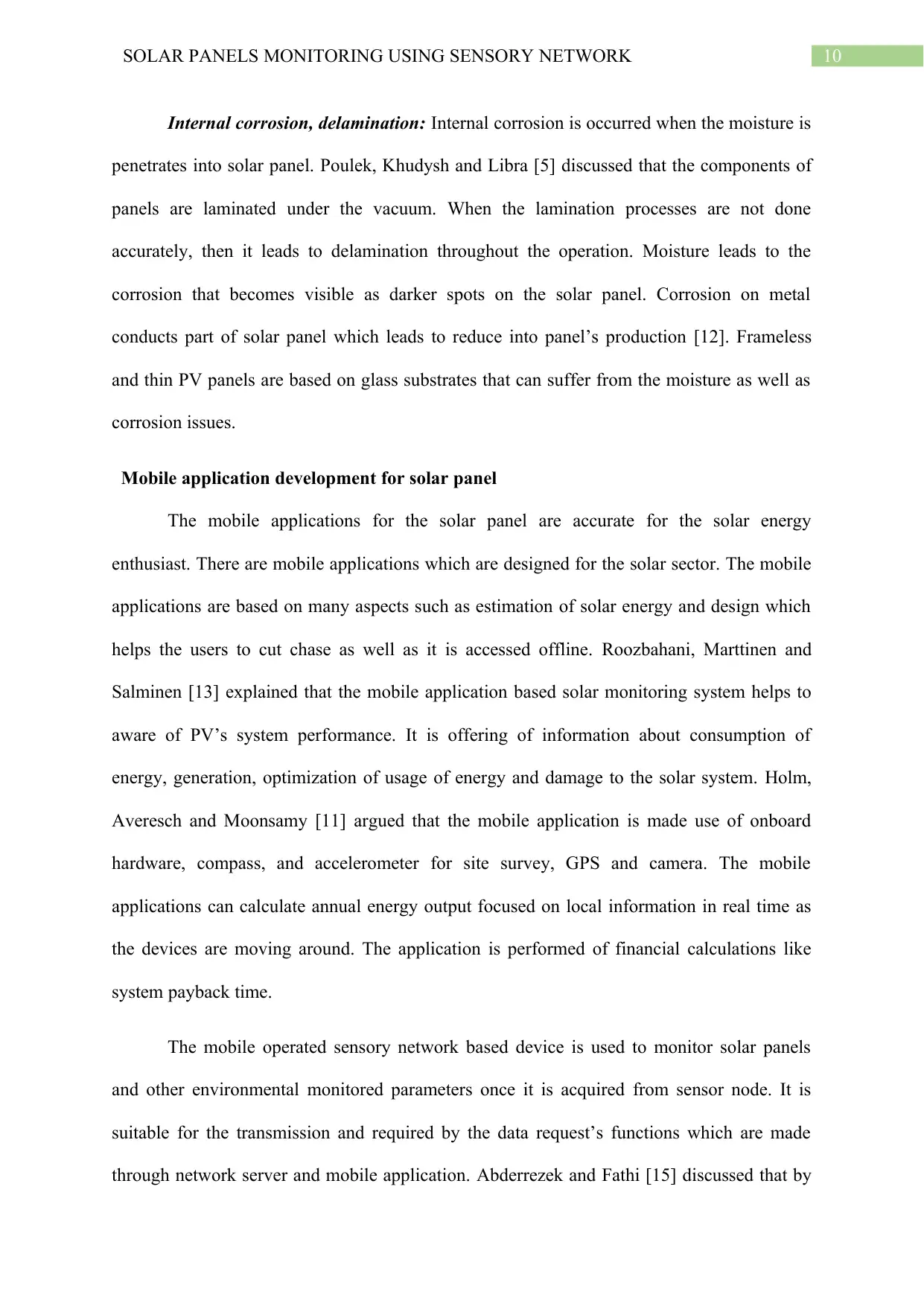
10SOLAR PANELS MONITORING USING SENSORY NETWORK
Internal corrosion, delamination: Internal corrosion is occurred when the moisture is
penetrates into solar panel. Poulek, Khudysh and Libra [5] discussed that the components of
panels are laminated under the vacuum. When the lamination processes are not done
accurately, then it leads to delamination throughout the operation. Moisture leads to the
corrosion that becomes visible as darker spots on the solar panel. Corrosion on metal
conducts part of solar panel which leads to reduce into panel’s production [12]. Frameless
and thin PV panels are based on glass substrates that can suffer from the moisture as well as
corrosion issues.
Mobile application development for solar panel
The mobile applications for the solar panel are accurate for the solar energy
enthusiast. There are mobile applications which are designed for the solar sector. The mobile
applications are based on many aspects such as estimation of solar energy and design which
helps the users to cut chase as well as it is accessed offline. Roozbahani, Marttinen and
Salminen [13] explained that the mobile application based solar monitoring system helps to
aware of PV’s system performance. It is offering of information about consumption of
energy, generation, optimization of usage of energy and damage to the solar system. Holm,
Averesch and Moonsamy [11] argued that the mobile application is made use of onboard
hardware, compass, and accelerometer for site survey, GPS and camera. The mobile
applications can calculate annual energy output focused on local information in real time as
the devices are moving around. The application is performed of financial calculations like
system payback time.
The mobile operated sensory network based device is used to monitor solar panels
and other environmental monitored parameters once it is acquired from sensor node. It is
suitable for the transmission and required by the data request’s functions which are made
through network server and mobile application. Abderrezek and Fathi [15] discussed that by
Internal corrosion, delamination: Internal corrosion is occurred when the moisture is
penetrates into solar panel. Poulek, Khudysh and Libra [5] discussed that the components of
panels are laminated under the vacuum. When the lamination processes are not done
accurately, then it leads to delamination throughout the operation. Moisture leads to the
corrosion that becomes visible as darker spots on the solar panel. Corrosion on metal
conducts part of solar panel which leads to reduce into panel’s production [12]. Frameless
and thin PV panels are based on glass substrates that can suffer from the moisture as well as
corrosion issues.
Mobile application development for solar panel
The mobile applications for the solar panel are accurate for the solar energy
enthusiast. There are mobile applications which are designed for the solar sector. The mobile
applications are based on many aspects such as estimation of solar energy and design which
helps the users to cut chase as well as it is accessed offline. Roozbahani, Marttinen and
Salminen [13] explained that the mobile application based solar monitoring system helps to
aware of PV’s system performance. It is offering of information about consumption of
energy, generation, optimization of usage of energy and damage to the solar system. Holm,
Averesch and Moonsamy [11] argued that the mobile application is made use of onboard
hardware, compass, and accelerometer for site survey, GPS and camera. The mobile
applications can calculate annual energy output focused on local information in real time as
the devices are moving around. The application is performed of financial calculations like
system payback time.
The mobile operated sensory network based device is used to monitor solar panels
and other environmental monitored parameters once it is acquired from sensor node. It is
suitable for the transmission and required by the data request’s functions which are made
through network server and mobile application. Abderrezek and Fathi [15] discussed that by
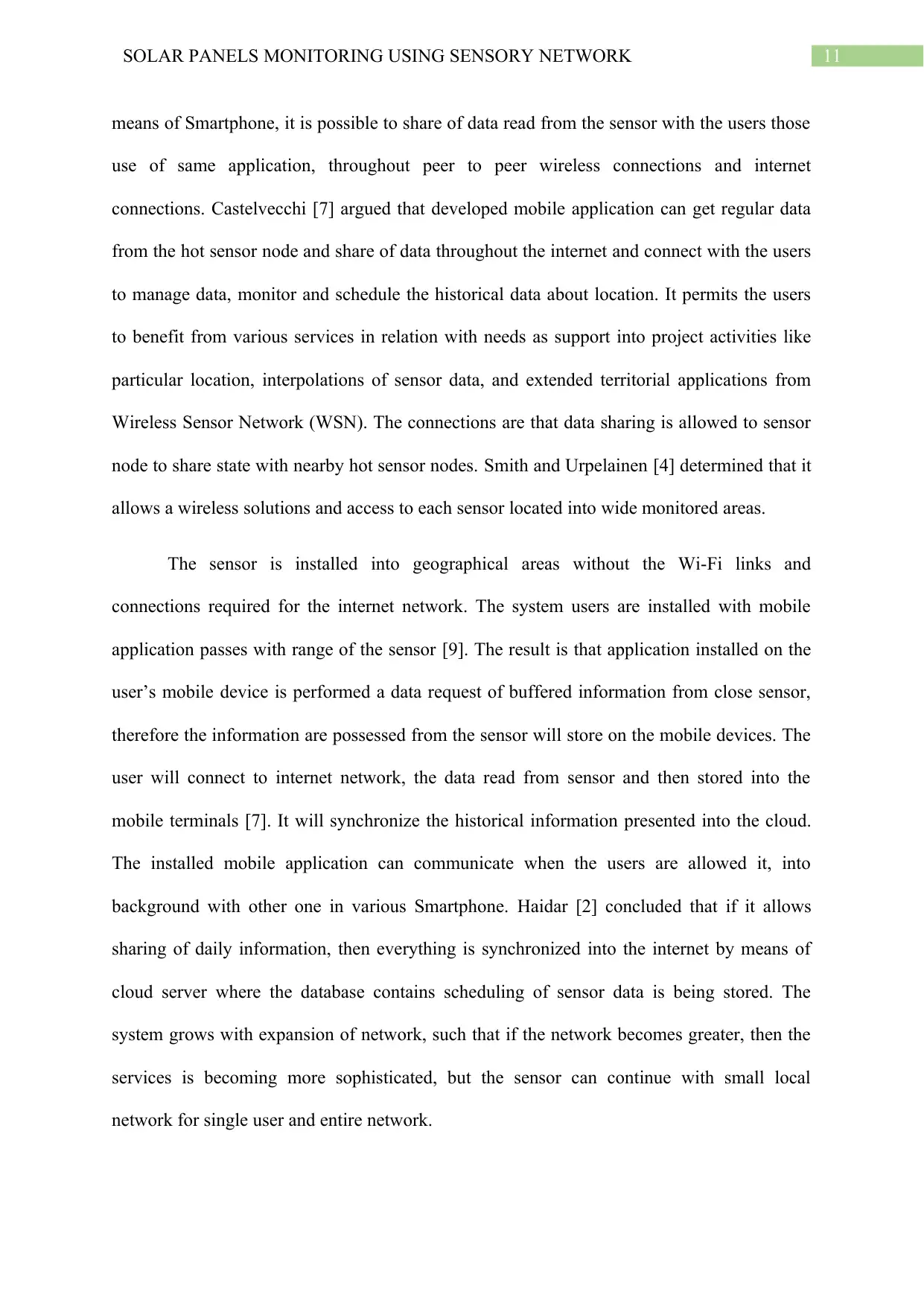
11SOLAR PANELS MONITORING USING SENSORY NETWORK
means of Smartphone, it is possible to share of data read from the sensor with the users those
use of same application, throughout peer to peer wireless connections and internet
connections. Castelvecchi [7] argued that developed mobile application can get regular data
from the hot sensor node and share of data throughout the internet and connect with the users
to manage data, monitor and schedule the historical data about location. It permits the users
to benefit from various services in relation with needs as support into project activities like
particular location, interpolations of sensor data, and extended territorial applications from
Wireless Sensor Network (WSN). The connections are that data sharing is allowed to sensor
node to share state with nearby hot sensor nodes. Smith and Urpelainen [4] determined that it
allows a wireless solutions and access to each sensor located into wide monitored areas.
The sensor is installed into geographical areas without the Wi-Fi links and
connections required for the internet network. The system users are installed with mobile
application passes with range of the sensor [9]. The result is that application installed on the
user’s mobile device is performed a data request of buffered information from close sensor,
therefore the information are possessed from the sensor will store on the mobile devices. The
user will connect to internet network, the data read from sensor and then stored into the
mobile terminals [7]. It will synchronize the historical information presented into the cloud.
The installed mobile application can communicate when the users are allowed it, into
background with other one in various Smartphone. Haidar [2] concluded that if it allows
sharing of daily information, then everything is synchronized into the internet by means of
cloud server where the database contains scheduling of sensor data is being stored. The
system grows with expansion of network, such that if the network becomes greater, then the
services is becoming more sophisticated, but the sensor can continue with small local
network for single user and entire network.
means of Smartphone, it is possible to share of data read from the sensor with the users those
use of same application, throughout peer to peer wireless connections and internet
connections. Castelvecchi [7] argued that developed mobile application can get regular data
from the hot sensor node and share of data throughout the internet and connect with the users
to manage data, monitor and schedule the historical data about location. It permits the users
to benefit from various services in relation with needs as support into project activities like
particular location, interpolations of sensor data, and extended territorial applications from
Wireless Sensor Network (WSN). The connections are that data sharing is allowed to sensor
node to share state with nearby hot sensor nodes. Smith and Urpelainen [4] determined that it
allows a wireless solutions and access to each sensor located into wide monitored areas.
The sensor is installed into geographical areas without the Wi-Fi links and
connections required for the internet network. The system users are installed with mobile
application passes with range of the sensor [9]. The result is that application installed on the
user’s mobile device is performed a data request of buffered information from close sensor,
therefore the information are possessed from the sensor will store on the mobile devices. The
user will connect to internet network, the data read from sensor and then stored into the
mobile terminals [7]. It will synchronize the historical information presented into the cloud.
The installed mobile application can communicate when the users are allowed it, into
background with other one in various Smartphone. Haidar [2] concluded that if it allows
sharing of daily information, then everything is synchronized into the internet by means of
cloud server where the database contains scheduling of sensor data is being stored. The
system grows with expansion of network, such that if the network becomes greater, then the
services is becoming more sophisticated, but the sensor can continue with small local
network for single user and entire network.
⊘ This is a preview!⊘
Do you want full access?
Subscribe today to unlock all pages.

Trusted by 1+ million students worldwide
1 out of 23
Related Documents
Your All-in-One AI-Powered Toolkit for Academic Success.
+13062052269
info@desklib.com
Available 24*7 on WhatsApp / Email
![[object Object]](/_next/static/media/star-bottom.7253800d.svg)
Unlock your academic potential
Copyright © 2020–2025 A2Z Services. All Rights Reserved. Developed and managed by ZUCOL.




